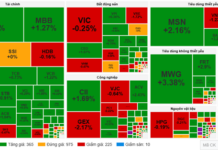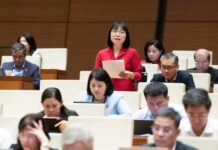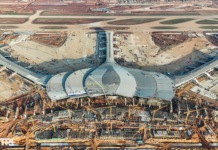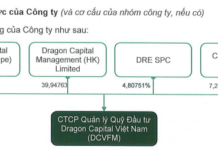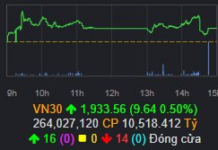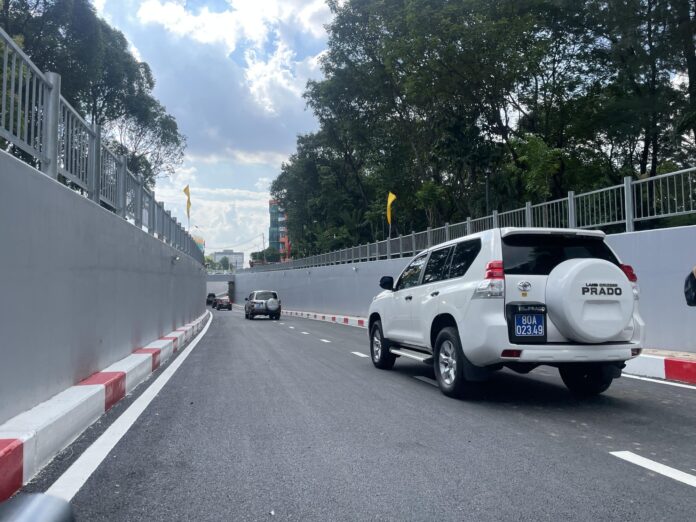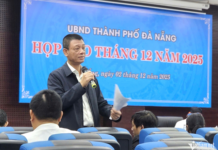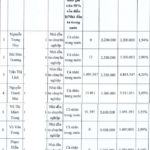Following the Vietnam Economic Forum 2024 – Session 3: “Unblocking Public Investment Disbursement”, Nguoi Lao Dong Newspaper continues to gather opinions from experts proposing solutions to accelerate the progress of one of the three pillars of economic growth in Ho Chi Minh City and the country.
Applying Resolution 98 to Public Investment
On August 16, in an interview with Nguoi Lao Dong Newspaper, Dr. Tran Du Lich, Chairman of the Advisory Council for the Implementation of Resolution 98/2023/QH15 on piloting mechanisms and policies for the special development of Ho Chi Minh City (Resolution 98), stated that public investment is one of the three pillars to boost economic growth and Resolution 98 is the most important decision in the current period to promote economic growth in Ho Chi Minh City as well as the whole country.
“Resolution 98 has made a significant contribution to the arrangement and disbursement of public investment capital. Specifically, this resolution allows the separation of a project into two parts: compensation and construction, thereby providing budget advances for compensation first to address bottlenecks. However, while new projects can be separated for compensation, ongoing projects have not been able to apply this approach. If Resolution 98 and other regulations continue to expand decentralization and delegation of procedures, it will actively promote public investment and mobilize resources for social infrastructure,” said Dr. Tran Du Lich.

Package 9 of the project connecting Tran Quoc Hoan and Cong Hoa Streets (Ho Chi Minh City) was just opened to traffic on the afternoon of August 10. Photo: Thu Hong
Also, according to Dr. Tran Du Lich, Ho Chi Minh City is summarizing one year of implementing Resolution 98, with many industries applying special mechanisms in their operations. After one year of implementing Resolution 98, the city has allocated VND 1,500 billion in public investment capital to support interest rates for investment projects in prioritized socio-economic development fields. The city has also issued 23 project lists to call for investment in the form of public-private partnerships in the fields of culture and sports…
According to experts, the city can apply the special mechanisms from Resolution 98 to promote the disbursement of public investment capital for key transport projects, including transport projects connecting with other localities. Dr. Truong Minh Huy Vu, Director of the Ho Chi Minh City Institute for Development Studies, said that urban railway projects, Ring Road 2 and Ring Road 3 are all planned to be implemented according to the TOD (Transit-Oriented Development) model. Therefore, he proposed supplementing the land fund planned for TOD when conducting auctions, and the money from the auctions will be used for the respective projects, with HFIC managing the funds instead of integrating them into the city’s general budget. “The implementation of TOD and green transport needs an innovative approach to organization. A strong commitment from specialized departments and sectors is necessary to ensure the timely implementation based on specific scenarios. For now, we must focus on completing the Metro Line 1 to demonstrate its socio-economic effectiveness, and then replicate it to the remaining 8 metro lines to ensure the completion of 180 km of metro by 2036,” said Dr. Huy Vu.
Regarding the legal framework in the process of implementing TOD, the Advisory Council for the Implementation of Resolution 98 proposed that each department and sector jointly develop a common plan, commit to the implementation schedule, and anticipate legal obstacles to report to the leaders of Ho Chi Minh City for timely recommendations to the central government.
Need for Clear Decentralization and Devolution
Mr. Nguyen Ngoc Hoa, Chairman of the Ho Chi Minh City Business Association (HUBA) and Chairman of the Board of Members of the Ho Chi Minh City Financial Investment State-owned Company (HFIC), stated that Resolution 98 is still in the exploratory stage and has not yet provided strong solutions. To create a breakthrough for public investment from this resolution, there is a need for clear decentralization and devolution so that the city can effectively address difficulties and obstacles. “There should be a stronger sense of urgency and a bolder application of Resolution 98,” said Mr. Hoa.
Dr. Huynh Phuoc Nghia, from the University of Economics Ho Chi Minh City (UEH), also believed that the effective implementation of Resolution 98 will contribute to promoting public investment. However, to achieve the expected growth in public investment, it requires a lot of synchronous mechanisms, policies, and procedures from Ho Chi Minh City to the neighboring provinces in the Southeast region and the central government. A coordination mechanism between Ho Chi Minh City and the ministries, sectors, and related localities is necessary during the project implementation process for Resolution 98 to truly become a “sharp tool” for the city. “Just recently, the city’s draft adjustment of the land price framework caused a stir in public opinion, while the issuance of a new land price framework is necessary and beneficial in many aspects. The application of the new land price framework is related to compensation and site clearance for public investment projects. This example illustrates the need for coordination between many departments, branches, localities, and central ministries and sectors to promote public investment. Ho Chi Minh City has a special mechanism, but when implementing it, coordination with central ministries and sectors is still required,” analyzed Dr. Huynh Phuoc Nghia.
From a broader perspective on the bottlenecks in public investment, the Chairman of HUBA pointed out that there are obstacles related to the planning, approval, bidding, and operational mechanisms. At the same time, there is a lack of synchronization in coordination between the functional agencies and the investors. “Public investment projects have enough funds but are hindered by mechanisms, procedures, and processes, requiring a holistic approach. The agencies and sectors need to be bold in changing their approach. Public investment projects should be socialized to address the bottlenecks. All procedures and approvals can be left to the private sector, and after completion, the projects can be inspected and accepted. This may be a smoother and faster approach,” suggested Mr. Hoa.
From another perspective, according to Assoc. Prof. Dr. Bui Quang Tuan, former Director of the Vietnam Institute of Economics, there is a significant issue in the implementation of public investment projects, which is the hesitation of the involved individuals. A safe legal framework is necessary so that those involved do not feel worried. While policies and regulations exist, each stage has a different understanding, and even the capacity for implementation and coordination between levels needs improvement. “It is necessary for Ho Chi Minh City to have Resolution 98 to create a space for piloting special mechanisms and policies, including in the field of public investment. The important task now is to review and identify what needs to be supplemented and adjusted after one year to ensure synchronization and effective implementation,” said Assoc. Prof. Tuan.
Applying Financial Mechanisms
According to Dr. Tran Du Lich, if the bottlenecks in the field of public investment are removed, the disbursement target of public investment capital set for this year, which is 90%-95%, will boost the economy and create a positive impact for the next year – the final year of the 2020-2025 period. Specifically, Ho Chi Minh City needs to continue implementing Resolution 98 to form a regulatory framework, including in the field of public investment. Through this, Ho Chi Minh City can meet the capital requirements and take advantage of two important financial mechanisms. “These are issuing bonds to increase the investment deficit to 120% to get ahead in some infrastructure investment projects and mobilizing private capital through various forms of participation in public investment, so that Ho Chi Minh City can move towards the stage of ‘for every VND 1 of state capital, VND 10 of private capital is attracted,’ said Dr. Tran Du Lich.
(*) See Nguoi Lao Dong Newspaper from the issue dated August 16
The Power of Lizen: Consistently Winning Massive Bids
Lizen has achieved a significant milestone by successfully deploying and implementing major high-speed construction projects in 2023. The company’s revenue has reached 2,030.5 billion VND, which is twice the amount compared to 2022. However, the post-tax profit has reached its lowest point in the past 6 years, dropping down to only 118.3 billion VND.
Three Economic Growth Scenarios for Ho Chi Minh City in Q1 2024
At the socio-economic meeting reviewing the results of January and setting the goals for February 2024, held this morning (1/2), the Ho Chi Minh City Institute for Research and Development has presented three economic growth scenarios for the first quarter of Ho Chi Minh City.
Supplemental Funding of Nearly 30.7 Trillion VND for Mid-Term Public Investment Plan
Deputy Prime Minister Le Minh Khai has assigned a budget of 30.683,441 billion dong to supplement the medium-term public investment plan for the 2021-2025 period from the central budget. This source of funding will be used to support infrastructure development and promote economic growth. The goal is to ensure that the investment projects are implemented effectively and contribute to the overall development of the country. With this additional funding, Vietnam aims to improve its transportation system, upgrade its public facilities, and enhance the quality of life for its citizens. The government believes that investing in infrastructure is crucial for sustainable development and will create favorable conditions for attracting domestic and foreign investments. The Deputy Prime Minister emphasized the importance of transparency and accountability in the implementation of these projects to ensure the efficient use of public funds. The government also encourages the participation and contribution of the private sector in these initiatives to maximize the benefits for the whole society.


